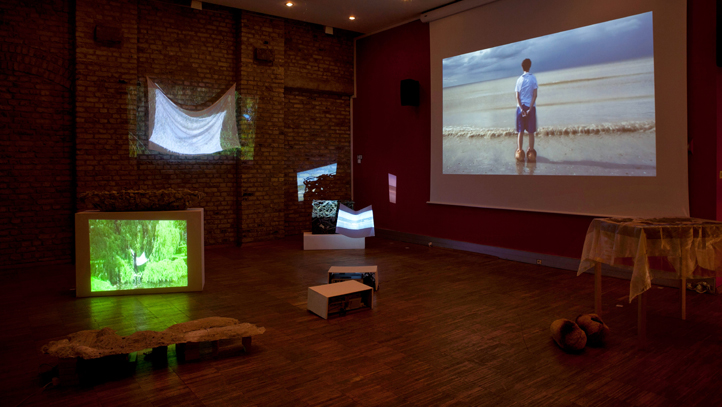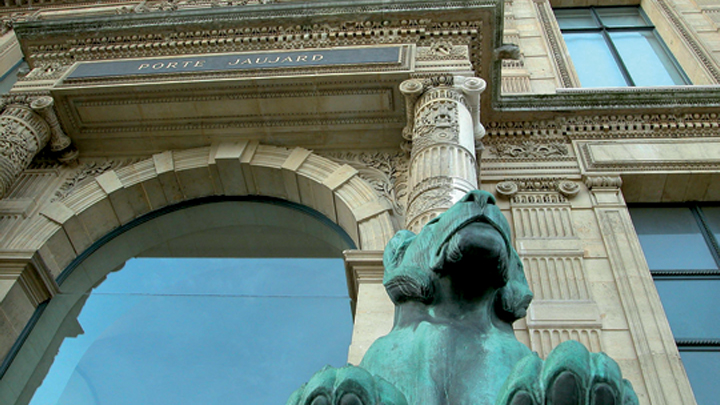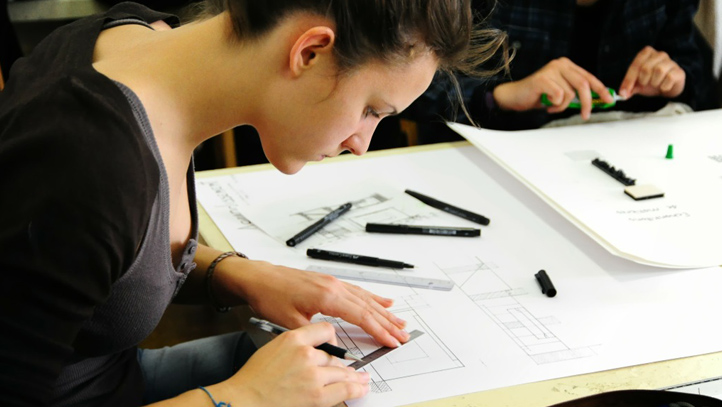You want to follow an artistic program in France
National public institutions in France have offered training in the classical arts—music, dance, and theater—since the end of the eighteenth century. Today, in Paris and in every region of the country, one finds public postsecondary schools of art (nearly 60), as well as schools administered by local chambers of commerce and industry (called écoles consulaires), private schools, and art-related programs in nearly 50 universities. Given this variety anyone can find a program to suit his or her educational goals.
Register and apply onlineLong you have prepared your “book”: present your work online! (website, blog, portfolio …)
Looking preferably Public postsecondary schools of art or Public postsecondary schools of applied arts (Écoles Supérieures d’Arts Appliqués, ESAA), public or private.
Visual Arts, Design (graphic arts, industrial design, interior design, fashion …) are available in more programs, but also cinema, new technologies …
The network now incorporates universities that offer not only many theoretical programs, but also management programs for a career in art. The network constitutes a center of excellence in French post-secondary education. In fact, cultural operators, event managers, directors and managers of artistic companies and various cultural centers of all kinds throughout the country now boast extensive and widely recognized know-how. Theorists and art critics, as well as “cultural managers” often come from universities.
Higher Schools of Art
Public postsecondary specific schools of art and design
These national public schools issue diplomas institutions.
Some qualifications of institutions confer master-level national diplomas in applied arts, visual arts, design and creation, industrial design, and photography:
• École Nationale Supérieure des Arts Décoratifs (ENSAD), Paris
• École Nationale Supérieure des Beaux-arts (ENSBA), Paris
• École Nationale Supérieure de la Création Industrielle (ENSCI-Les Ateliers), Paris
• École Nationale Supérieure de la Photographie (ENSP), Arles
• Le Fresnoy – Studio National des arts contemporains, Tourcoing
Two schools offer a 2–4 year curriculum in theater and film:
• École Nationale Supérieure des Arts et Techniques du Théâtre (ENSATT), Lyon
• « La Fémis » – École Nationale Supérieure des Métiers de l’Image et du Son (ENSMIS), Paris
Public postsecondary schools of Art and Design, national and territorial
45 Public postsecondary schools of Art and Design, under supervision of the Ministries of Culture and, Higher Education, Research and Innovation, provide training in visual arts and are implanted in different cities of France. These school are sites of training and creative activity that combine learning with practice in the artistic act, artistic theory, research, and experimentation in contemporary art and design. Programs are offered at two levels (capping 3 or 5 years of postsecondary study). These schools confer national diplomas in art, design, and communication. The 1st cycle confers Licence-Level diploma and the 2nd cycle diploma confers the degree of Master.
• Public Schools list : www.andea.fr
• Charters for Studies and Research in Art Schools and French Public Highet Art Schools network – ANdEA web site
Public postsecondary schools of applied arts
French arts, crafts, and know-how are found in more than 38,000 workshops, 100,000 artisanal enterprises, and 217 different occupations grouped into many specialty areas. The ESAAs award national diplomas in very specific areas upon completion of a 2–4 year curriculum. Graduates are prepared to begin careers in a variety of design-related fields: graphic design (media, multimedia); spatial design (interior architecture, lifestyle, sets); fashion, textile, and environmental design; design of products and services; and crafts (textiles, jewelry, books, glass, ceramics, and others).
• List of ESAAs: https://designetmetiersdart.fr>Formation
Register and apply onlineMusic, dance, drama … In France there are four major types of conservatories: the National Conservatories of Music and Dance (CNSMD only two in France: in Paris and in Lyon), Conservatories in Regional Radiation (CRR), the Conservatories in Departmental Radiation (CRD) and Conservatories to radiation Communal (CRC). The CNSMD, CRR, CRC and CRD work in partnership with universities and offer part of the LMD system courses.
• Conservatories’ list: https://www.culture.gouv.fr/Sites-thematiques/Musique/Enseignement-formation-et-metiers
Register and apply onlineThree public schools of historic and cultural heritage offer advanced programs. Some curricula prepare students for careers requiring knowledge of historic and cultural heritage (art historians, guides and presenters), others for careers involving its preservation (conservators, restorers, architects of historic monuments and properties).
• École du Louvre (EDL), Paris : 1er cycle, 2e cycle, 3e cycle, muséologie
• École Nationale des Chartes (ENC), Paris
• Institut National du Patrimoine (INP), Paris
Other institutions offer degrees with conservation, restoration, heritage’s specialties : l’École Supérieure d’Art et de Design TALM – Tours, l’Université Polytechnique Hauts-de-France, …
Many private schools offer 3- to 5-year postsecondary programs. The degrees are particular to each school and vary widely in cost and quality. Some of the certificates and titles conferred are registered in the RNCP, the National Directory of Professional Certification. The National Directory of Professional Certification (https://www.francecompetences.fr) is the official organization under ministerial supervision, responsible for validating these degrees and classify them according to the level of employment. (https://www.francecompetences.fr).
Register and apply onlineMost French programs in art history and theory – history of art, theater, cinema, and music – are offered in the universities at all three major degree levels: Licence (bachelor), master, and doctorate. Academic programs leading to a Licence professionnelle or professional master include a practical training component.
Universities offer three major art tracks:
• Performing arts : with programs in film analysis, the history of directing, and so on
• Fine arts : with programs in art history, the analysis of works of art, and aesthetics, among other subjects
• History of art : with programs in the history of artistic creation, painting, sculpture, architecture, and more.
Research in artistic fields is performed by more than a hundred teams affiliated with about 30 doctoral departments operating within institutions throughout France.
Register and apply onlineTestimony
Visual Arts:
Applied Arts:
Art degrees and Culture within the LMD system
Art school admissions
Post-baccalaureate or equivalent, or after a preparatory year or level two years of art studies, admission to schools of public or private art and conservatories is made by a selective competition and portfolio presentation.
Many programs prepare for the entrance examination of public and private art schools.
• List of Public preparatory classes’ list in the National Association of Public Preparatory classes for the Graduate Schools of Art (APPEA) network: www.appea.fr>Liste et carte des écoles
• List of classes and preparatory courses integrated in art schools list: www.andea.fr/fr/formations/060613-classes-preparatoires
Register and apply onlineDegrees in Art and Culture
France’s postsecondary schools of art and applied arts, like its universities, are excellent public institutions that award national diplomas recognized by the French government and transferable credits under the European Credit Transfer System.
Degrees in Art and Culture
Recognition and certification of qualifications
The National Commission for Professional Certification is an agency state charged with developing a new classification of certification levels, could allow the European and international comparisons through transparency implies. Outside of qualifications in higher education Level I and II (bachelor, master, diploma referred …), all certifications should be included soon.
WARNING: many institutions, generally private, yet intitulent degrees they issue “Master”; it is not Master degree (awarded by the University), but establishment titles which are described only Master level: an indication of the number academic years after the baccalauréat. To be eligible to enroll in 3 cycle University degree (PhD) must have a diploma conferring the rank of Master.






















